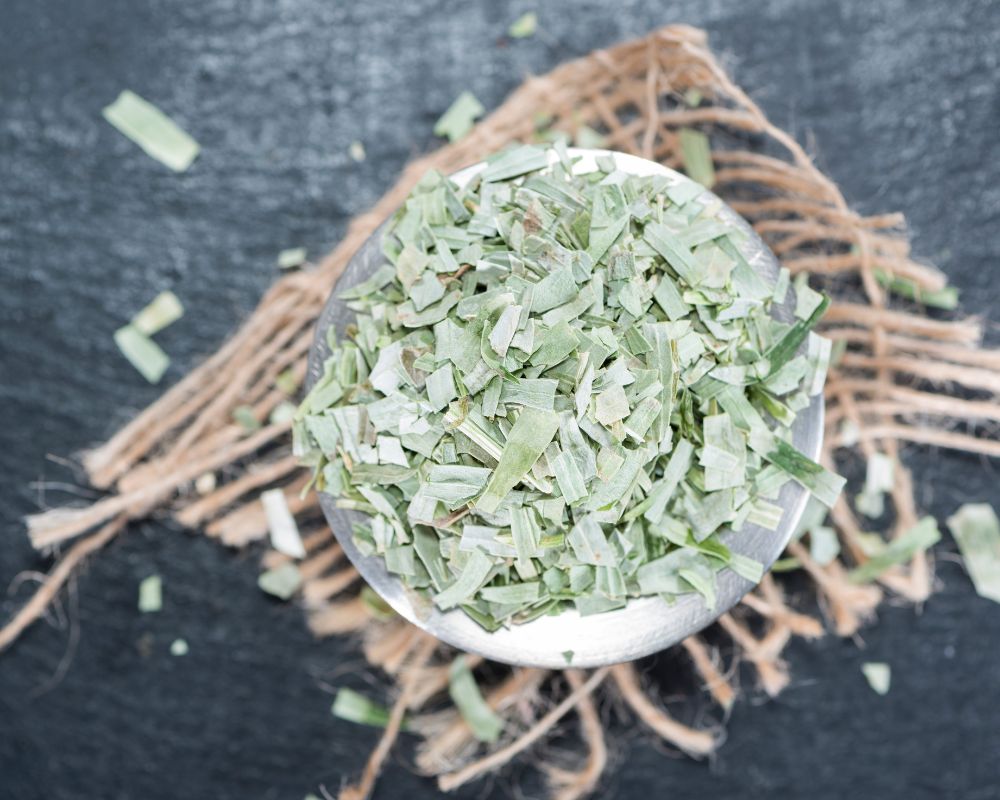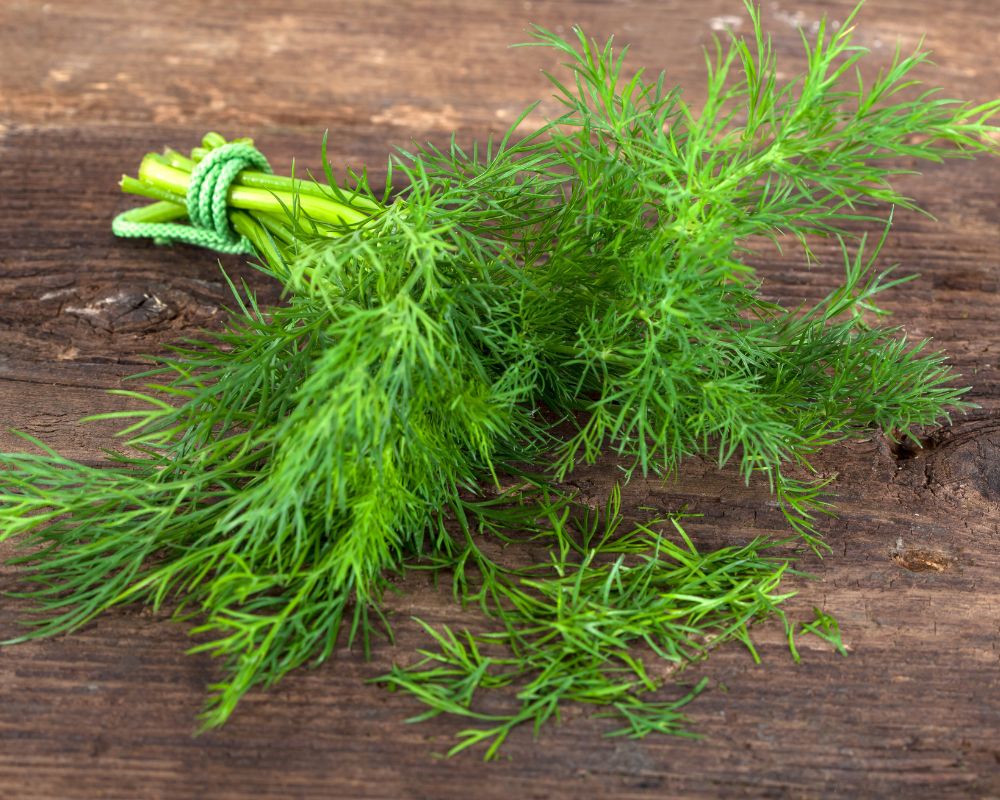Dried dill comes from the dehydrated green leaves of dill plants. The crunchy dried leaves have a grassy, slightly buttery, anise-like licorice flavor with undernotes of sweetness and tangy lemon citrusiness. You can use the dried herb in ranch dressing, dill pickles, and tzatziki.
Table of Contents
What is dried dill?

Dried dill refers to the dry leaves of the dill plant (Anethum graveolens). The delicate culinary herb is obtained from drying fresh dill leaves in the air, microwave, oven, or a food dehydrator. You can also dry dill flowers and tender stems together with the leaves.
Dried dill is also called dried dill weed or dried dill weed.
| Origin | Eastern Europe and are native to Asia |
| Appearance | Feathery green leaves that retain their green color when dried |
| Flavor profile | Has a grassy, slightly buttery, anise-like licorice flavor with hints of sweetness and tangy lemon-citrusiness |
Origin
Dill plants originate from Eastern Europe and are native to Asia, the Mediterranean, and Europe. The fresh or dried leaves of the plant work as a culinary herb, while its fresh or dried seeds work as a spice.
Dried dill is a popular flavoring herb in Scandinavia, Western Europe, and Germany. Its usage spreads to Vietnamese, Turkish, Eastern European, Indian, Middle Eastern, and Nordic cuisines. In the US, it’s common in dill pickles and ranch dressing.
Appearance
Dill plants have feathery green leaves that retain their green color when dried. After drying, the leaves may be left whole or crumbled into a rough, crunchy texture. You could also grind them into a smooth powder.
Flavor profile
Dried dill has a grassy, slightly buttery, anise-like licorice flavor with hints of sweetness and tangy lemon-citrusiness. Their aroma is herbal and reminiscent of caraway, parsley, and fennel.
Nutritional Benefits of dried dill
Dried dill is rich in manganese, and vitamins A and C. Manganese helps your body metabolize fat and sugar and maintain a healthy brain and nervous system.
Vitamin A helps with immunity and vision, while vitamin C helps with metabolism, healing wounds, bone formation, and immunity.
The flavonoids in dill can help reduce the risk of stroke, heart disease, and some cancers. Dill has terpenoids that may protect you from brain, liver, kidney, and heart diseases.
Dill can reduce stomach problems and help calm colic babies. It may also stimulate milk production in breastfeeding mothers.
Dried dill vs. fresh dill: comparison

Fresh dill leaves have a deeper green color, while dried dill has a lighter green color because of the slight color loss during drying.
Dried dill leaves have a stronger flavor than fresh herbs. The drying process removes water from the leaves, which causes the taste to get more concentrated.
Dried dill weed is better for recipes with bolder flavor, such as meat dishes. It works well with dried dill seeds, which are even better for savory dishes like meat.
Fresh dill is better in recipes that require a milder flavor, such as pickles. Use it to flavor cucumbers in dill pickles. For the best dill pickles, it’s best to use dill seeds because of their more pronounced flavor.
Dried dill vs. dill seeds: comparison


Dill seeds work as a spice since they pack some heat. They are actually the fruit of the dill plant and are used fresh or dried. The tiny, oval-shaped seeds have a tan to dark brown color.
Dill seeds overpower the flavor of dill leaves. They are slightly earthy, spicy, lemony, and slightly bitter, with hints of parsley, celery, and anise. They have more caraway flavor than dill leaves.
Unlike dill leaves, which are delicate and added toward the end of cooking, dill seeds require you to add them earlier for a longer cooking process. This helps them release flavor completely.
Can I use dried dill instead of fresh?
It’s not advisable to use dried dill instead of fresh dill. Dry dill has a stronger flavor, which may ruin recipes requiring a milder dill flavor.
If you must use dried dill to substitute fresh dill, start with smaller amounts and add more taste.
You can use dried dill to flavor dishes such as:
- Dill pickles
- Dips
- Marinades
- Potato salad
- Poultry
- Salad dressings
- Seafood and fish
- Soups
- Stews
- Tzatziki (Greek cucumber yogurt salad)
- Vegetables
How to dry dill?
The best way to dry dill to preserve its green color and flavor is in a food dehydrator. Follow the steps below to dehydrate your dill leaves:
- Remove the yellow flowers (if preferred) and brown leaves.
- Clean the leaves under cool running water.
- Blot the wet leaves with paper towels to remove excess water. Alternatively, use a salad spinner to avoid breaking them.
- Cut the stems into smaller pieces to make it easy to fit them on dehydrator trays.
- Place the leaves on dehydrator trays and dehydrate them at 95°F-100°F for 4-6 hours until crumbly.
- Keep checking the progress upon the hour. If your dehydrator’s fan is the bottom, rotate the trays for even drying.
- After the fourth hour, remove some leaves and cool them to room temperature before testing them for dryness. If they aren’t fully dry, continue drying to the sixth hour or until dry.
- Take out all the dried leaves, remove the stems (if preferred), and allow them to cool to room temperature before conditioning and long-term storage.
- To condition the leaves, place them in glass jars and monitor them for 3-7 days. If no mold or condensation occurs, store them long-term. Re-dehydrate any leaves that stick to each other or condensate in the glass jar.
How do I store dried dill to extend its shelf life?
You can expect dried dill to last 4-6 months when you store it at room temperature in airtight glass spice jars in a cool, dry, dark place.
Keeping the herb at room temperature in vacuum-sealed airtight containers will extend its shelf life to 12 months. A 12-month shelf life is also possible if you store the dried herb in the freezer in freezer-safe containers or mylar bags.
Freeze-dried dill can last up to 25 years in glass jars in a cool, dry, dark place.
What is a substitute for dried dill?




The delicate nature of dried dill makes it hard to replace. However, you can have success with the following options:
- Dried fennel
- Dried parsley leaves or parsley flakes
- Dried tarragon
- Fresh dill weed (in a pinch)

